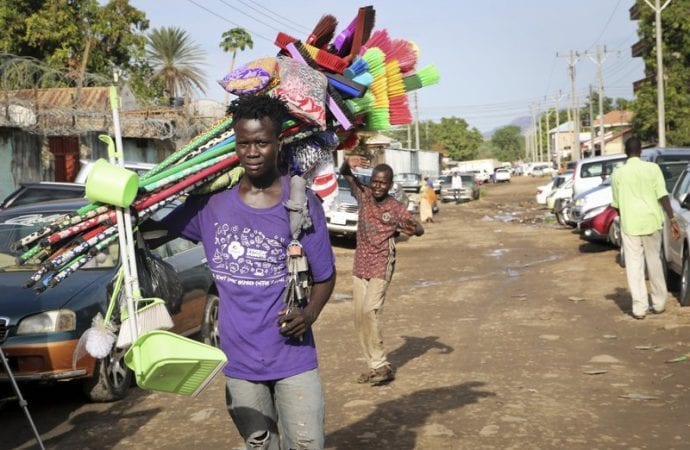A project to build a school is bringing together members of the two main ethnic groups in South Sudan and is building hope for peace in Africa’s youngest - and conflict-ridden - country.
The Nuer and Dinka ethnic groups have usually fought over pastureland and water resources, but the community-led initiative to build a school in the town of Duk Puyuel could help build trust between the two peoples.
According to Duot Gideon Dau, Catholic Relief Services Social Cohesion Program Manager in South Sudan, members of the remote community are trying to make sure that children from both the Dinka and Nuer ethnic groups are studying together at the same school.
“When children from different ethnic groups are kept apart, they don’t have the opportunity to understand and connect with children in neighboring ethnic communities. That can lead to misunderstandings, negative perceptions, and potential conflicts in the future,” Dau told Crux.
“In Payuel, the school brings Nuer and Dinka children together, which can help foster friendships, mutual understanding and respect. Parents also have the chance to get to know one another. Giving children the opportunity to enroll and complete their schooling also reduces the likelihood that they would become involved in conflict,” he added.
Dau described the initiative as “a really good example of a locally-led effort,” noting that members of the community have donated their own time and money to rebuild the school and hire teachers.
“While this is not a Catholic Relief Services project, around 40 of the people taking part in fundraising and renovations are Catholic Relief Services staff. It hasn’t been easy, but it was all worth it because we were able to open the school in the beginning of July. There is still a lot to do. The school still needs desks, chairs and other scholastic materials,” he told Crux.
Years of fighting have devastated the South Sudan education system, with more than 2.2 million school-aged children forced out of school, according to Education Cannot Wait (ECW) - a first global fund dedicated to education in emergencies and protracted crises.
The school in Duk was first destroyed in the 1990s, and then rebuilt in 2008-2009, before being destroyed again in 2014.
“The roofing, doors and windows were all taken, so that all that was left standing were some of the walls,” said Will Baxter, East Africa Regional Information Officer for Catholic Relief Services in an email to Crux.
And that was just one of the hundreds of schools destroyed in South Sudan. According to the 2018 report by the Global Coalition to Protect Education from Attack, between late 2013 and January 2016, violence destroyed more than 800 schools.
In 2017, the Global Education Cluster (GEC), a forum for coordination and collaboration on education in humanitarian crises, reported that 31 percent of all schools in South Sudan had suffered some form of attack by armed forces or non-state armed groups between December 2013 and the end of 2016, including being commandeered for military use and threats targeting students and teachers.
These numbers represent a dramatic rise over the 100 attacks on schools recorded between 2009-2013.
“The destruction of many schools in South Sudan could leave an entire generation of South Sudanese without access to an education,” Dau told Crux.
“Re-establishing the country’s rural schools is particularly challenging as these are in remote and often inaccessible areas. Local communities, such as this one in Duk-Payuel, are self-organizing rather than waiting for external support to arrive. These communities believe rural schools are vital for the recovery and prosperity of the country,” he said.
Understanding South Sudan’s ethnic strife
The Dinka and the Nuer conflict dates back to the 19th century, but the ethnic strife was set aside during the half-century long civil war between the Muslim Arab government of Sudan’s north and rebels from the predominantly Christian south.
In 2005, a comprehensive peace agreement was reached between the Sudanese government and South Sudanese rebels. The agreement laid the groundwork for a referendum on whether Sudan should be split in two, with South Sudan becoming an independent country.
That referendum took place in January 2011, with nearly 99 percent of South Sudanese opting to secede. The new Republic of South Sudan formally came into existence on July 9, 2011.
After the initial euphoria of independence, the simmering ethnic tensions between the South Sudanese began to boil over.
The president of the new nation, Salva Kiir - a Dinka - accused his former Prime Minister, Riek Mashar - a Nuer - of fomenting a coup d’état.
Mashar levelled accusations of his own against the president, accusing Kir of planning to assassinate him. This personal feud spiraled into a full-scale civil war in December 2013 that has so far killed around 400,000 people. A fragile peace deal was signed in September, although sporadic fighting continues.
Peace in South Sudan has become a very delicate issue, but Dau said he believes small efforts, like rebuilding the community school in Duk, hold the key to a sustainable peace in the country.
And it’s the kind of effort the Catholic Relief Services - the international development arm of the U.S. bishops’ conference - has been supporting for a long time in South Sudan.
John O’ Brien, the CRS country representative in South Sudan, said the organization is working with church partners at the local, national and international levels to promote a just and lasting peace in the country.
“Catholic Relief Services supports early warning and early response to local conflicts, responds to the trauma experienced in conflict-affected communities and champions the role of the Church as a trusted peacebuilder,” he said.

